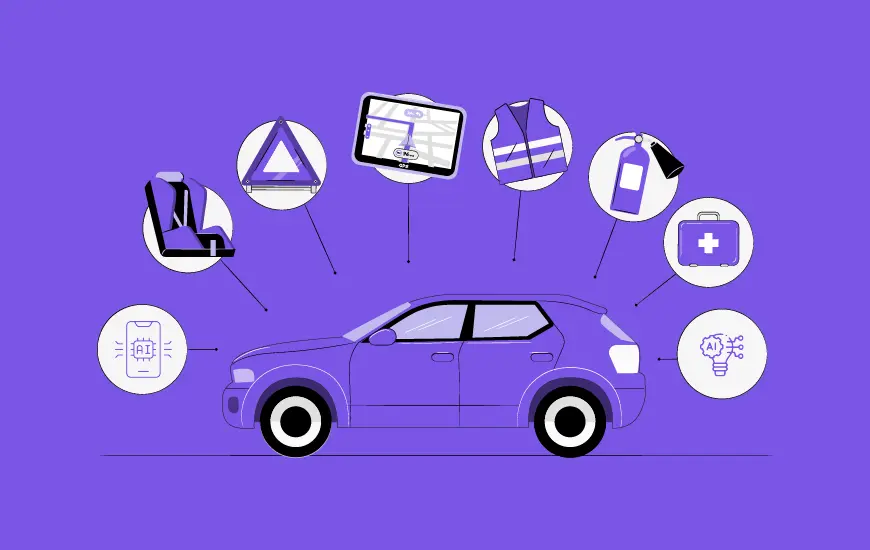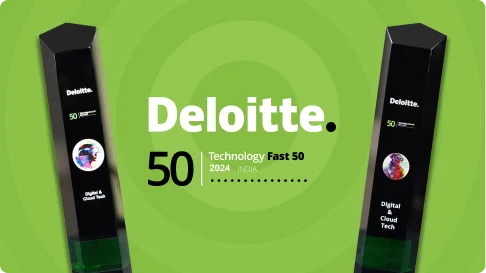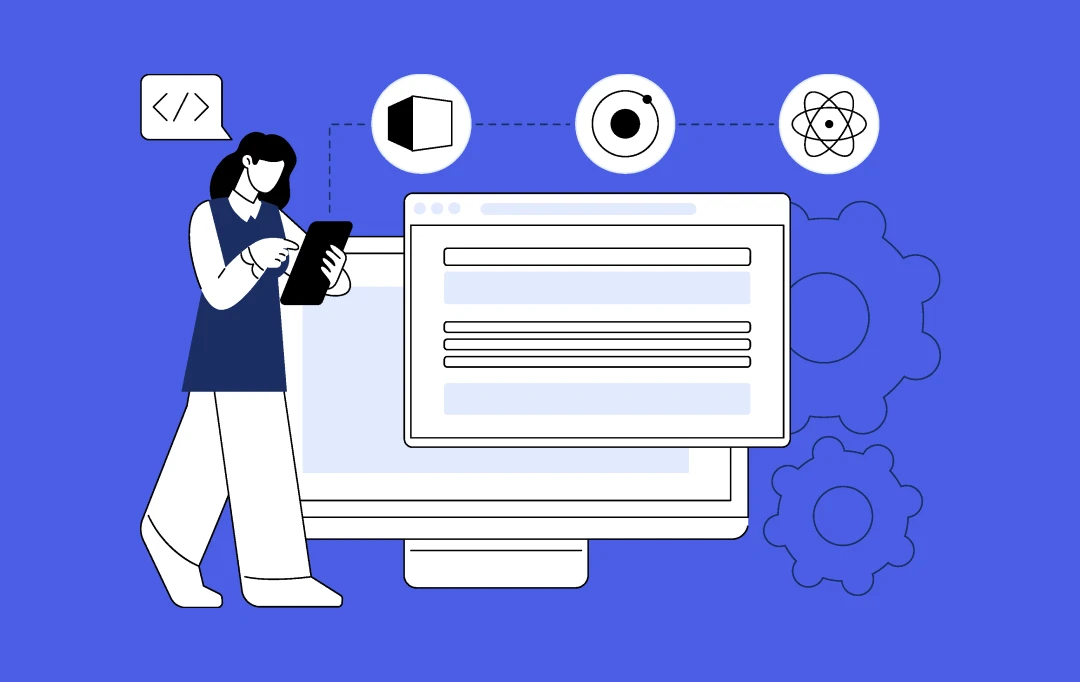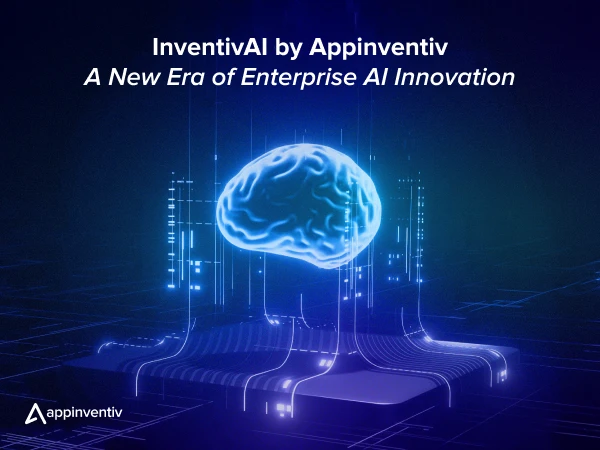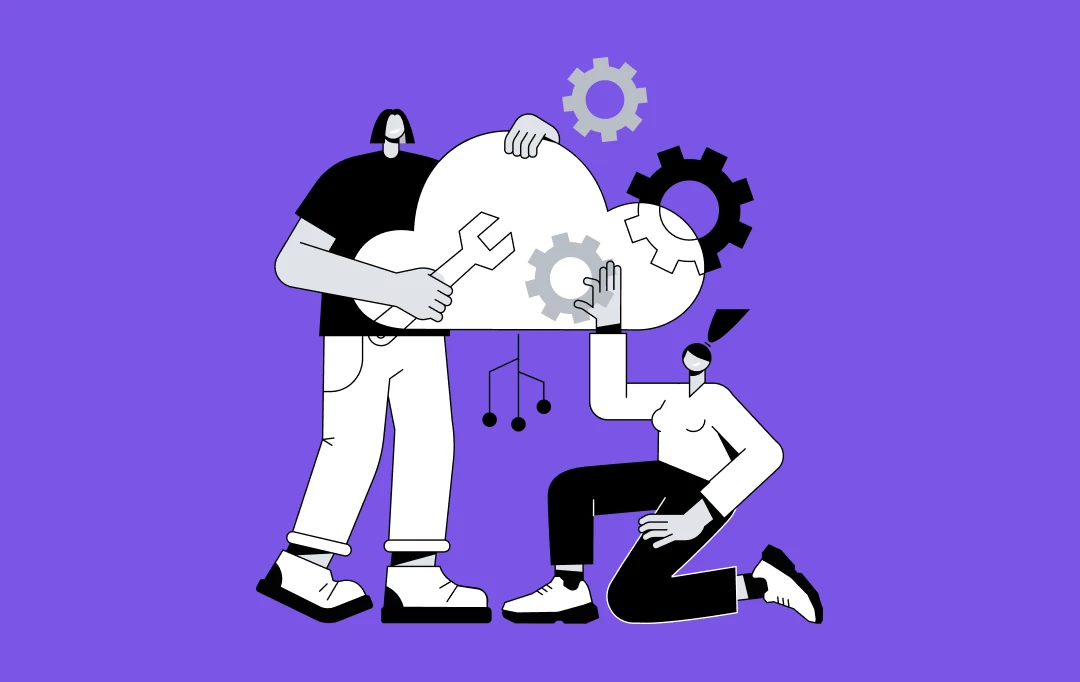- What is Django?
- What is Ruby on Rails?
- Django vs Ruby on Rails Frameworks: What is the Difference?
- Language
- Architecture
- Popularity
- User Interface
- Speed and Performance
- Stability
- Installation
- Security
- Scalability
- Syntax
- Principles of Development
- Documentation of Frameworks
- Maturity of Platform
- HTML Templating
- Usage
- Web Servers
- Community Support and Ecosystem
- Learning Curve
- Use Cases of Django
- Use Cases of Ruby on Rails
- Django vs Ruby on Rails - Comparison Summary
- Django vs Ruby on Rails – Which Framework to Choose and When?
In the world of programming, there are numerous web development frameworks available to developers, but as we all know Django and Ruby on Rails stand out the most. They are emerging as the most popular web frameworks and this popularity will continue to rise in the coming years as well.
However, we have a debate at hand right now, so let’s take a look:
Person 1: “Django is the best web development framework as it offers easy and understandable code.”
Person 2: “Well, Ruby on Rails offers an expeditious development process, which gives it an edge.”
Such discussions regarding Django vs Ruby on Rails are becoming widely popular and unending debates still continue to exist. In such a scenario, we have done our research to present our take on it.
Because both of the frameworks are loved by top web and mobile app developers, we have compared them both on 18 points of difference. However, before anything, first let’s clear out the air around what they are.
What is Django?
Released back in 2005, Django is a Python-based web framework, and a primary choice for Python app development. What makes it so popular is that it is a general-purpose, open-source, and free framework. Features of Django are highly praised by developers. It was designed with the purpose of simplifying the process of creating complex and database-driven websites. This framework encourages rapid development with a neat and pragmatic design.
What is Ruby on Rails?
Written under MIT License, Ruby on Rails, is a server-side, open-source web app framework. Being a model-view-controller, Rails provides amazing default structures for a database, web services, and pages. It is considered a time-saving method for developers to write code.
This framework works majorly on two principles – DRY (Don’t Repeat Yourself) and Convention Over Configuration. The former being self-explanatory eliminates the need of doing the same task of coding again and again, while the latter means that the environment you work in, such as systems, libraries, languages and more, allows many logical situations by default. That means you can adapt to them instead of creating your own rules each time, making the whole programming process a whole lot easier.
Django vs Ruby on Rails Frameworks: What is the Difference?
Language
While Django uses Python, Rails is developed using Ruby. Python ranks among the top programming languages and is known for emphasizing clarity and readability of the code, whereas Ruby is renowned for its attributes such as flexibility and freedom and also for its understandable syntax.
(Learn more about Python in our article “PHP vs Python: Which Language Is Dominating The Market?”)
Moreover, Python is the easiest programming language to learn and write fast. There are various kinds of applications that can be developed with Python.
On the other side of the table, Ruby was designed with the emphasis on “enjoying” writing the language. Though the applications built using either of them will look and function almost exactly the same, the main difference can be seen under the covers.
Architecture
One thing that both the web development frameworks have in common is both have adopted MVC (Model-View-Controller). However, for Django, it is called MVT (Model-View-Template). Both MVC and MVT are similar for the most part and differ ever so slightly.
In Django, the Model represents the database that describes the data structure, View is the Regular Expression-based URL Dispatcher which controls what the users are supposed to see. Last but not least, Template signifies a web templating system that amalgamates with Django Template Language (DLT). The controller part here is handled by Django itself.
As for RoR, the Model denotes the data of the database such as comments, pictures, posts, etc. All this is taken care of by ActiveRecord. Here, the View covers the data in the HTML template and then sends it to the Controller, which then later is handled by ActiveView. Now, the ActionController is the one to connect Model and View and handle requests while also taking care of sending responses to the web browser.
Popularity
In the battle of Ruby on Rails vs Django popularity, Django is more popular than Ruby on Rails, mainly because Python is incredibly popular. It is one of the most popular programming languages, and its popularity is growing faster than ever. This also means that there are huge amounts of libraries and packages available for Python/Django that can be leveraged to get features built quickly.
User Interface
When comparing Django vs Ruby on Rails on the grounds of the user interface, they both are absolutely the winners. It is because both of them are created to offer a high-class customer experience. These web-centered frameworks allow every web app development agency to develop highly-functional websites loaded with impeccable add-ons and plugins.
Speed and Performance
In the battle of Django vs Ruby on Rails performance, it is observed that Rails is faster by 0.7%. It is because Rails has the advantage of a rich repository of amazing libraries and plugins to enhance the speed and eventually the performance of this framework. Nevertheless, Django equally encourages expeditious development processes and is an incredible choice for a web framework.
Django REST framework delivers convenience in the form of authentication modules, JSON serializers/deserializers, etc. When comparing Django vs Rails development frameworks, we can say that Django may have an edge as REST is one of the prominent advantages of Django.
Nevertheless, in the battle of Ruby on Rails vs. Django performance, both are leading the race as they leverage modern programming languages while providing the tools to optimize the code.
Stability
Creativity and stability are two parallel elements that are necessary for development. We could consider the one winner who can handle both effectively. Ruby on Rails has the ability to juggle both as it lets users reuse the code to minimize the dependencies. It also uses the Convention over Configuration approach, freeing the coders from any additional efforts.
On the other side of the table, Python practices a more conventional approach by sticking to any proven method to solve the problems at hand, providing stability.
Installation
Comparing Ruby on Rails vs Python Django on the basis of the installation process is not a hard nut to crack. Django’s installation process is very easy, and hence, it only takes about a minute to install it completely.
However, the same thing cannot be said about RoR. You need to first understand what Bundle and Gems are, as they are needed to install the packages for Ruby. First, install these two and then run Command Gem Install Rails to install the latest version of the Rails framework.
Security
In Django vs Rails comparison, we had to include the security factor as it is an indispensable part of any website or applications for that matter.
Django has definitely gained this feature from Python. In fact, NASA also uses the Django framework python, which is a fact enough in itself to advocate how secure it is. Django is backed with middlewares while Rails is supported with active records. Django has tools that safeguard your Django app from SQL injection, cross-site scripting (XSS), etc., and so does Rails.
All in all, both the Django web development framework and Ruby framework are a reliable options and can be trusted for security.
Scalability
Though the Django web framework has inherited scalability from Python, it still lags behind a little in comparison to Rails. It has better scalability, which is the result of its attributes such as freedom and flexibility of code. They both are heavyweight web development frameworks, so they both are designed keeping scalability in mind, but Ruby on Rails development here takes the winner title.
Syntax
It is a known fact that Ruby’s syntax is highly flexible. Well, this can not always be associated with the advantages of Ruby on Rails. It can cause problems and makes it harder to pass on the project to other team members as one feature can be achieved in many distinct ways, creating confusion.
Whereas, Python advocates that there should be only one obvious way to do something, making the code easier to debug and read.
Principles of Development
Principles are like the glue that holds the whole app development process together. Django web framework has two prominent principles that are noteworthy – DRY (which we had discussed already) and “Explicit is better than Implicit”. This principle lets developers create applications that are easy to understand and are maintained by numerous people.
Ruby on Rails is likewise not short on development principles. It also uses DRY and Convention over Configuration, which advocates that to be productive you must follow conventions instead of creating your own configurations. Doing this increases speed and efficiency.
Documentation of Frameworks
To be straightforward, it’s a tie between Django vs Rails development frameworks in this respect. Both the frameworks are well documented, making it easy to find the most popular FAQs and answers to the queries. The language of the documentation of both is very easy, understandable, and straightforward, without putting the reader into the a state of mayhem.
Maturity of Platform
Django was first introduced in 2005 and since then has been working its way up in the list of the best web development frameworks. Its recent version was released in December 2021 with many new features and better functionality.
Ruby on Rails was first introduced in 2003 but was officially declared as an open-source framework in 2004. It is also regularly updated, as the latest version of it was launched in February 2022.
HTML Templating
Although both Django web development and Ruby on Rails framework have templating as a core feature, Django web framework uses a simple templating language in order to enable developers to build templates with minimal programming and HTML skills. On the contrary, Rails’ views (individual page templates) seem more complex.
Usage
If you are looking for a framework that helps in developing complex database-driven websites and web apps in less time, with efficiency in system administration, scientific programming, data analytics and manipulation, then the Django web framework is the way to go.
On the other hand, Rails also assists in developing database-backend web apps by providing better usability and freedom to programmers. Because Ruby is flexible in nature, it is an ideal choice for meta programming and creating pleasing codes.
Web Servers
For the Django web framework, the main web servers are NGINX using WSGI, Apache, Gunicorn, and Cherokee. The database servers for Django are SQLite, PostgreSQL, MySQL, and Oracle.
The Ruby on Rails web framework uses NGINX, Apache (running Phusion Passenger Module), and WEBrick as the prominent servers. Database servers for Rails include PostgreSQL and MySQL.
Community Support and Ecosystem
Django being an open-source framework, also has an open-source ecosystem, implying that there is a sea of libraries and tools, both paid and free, available to developers. Moreover, the official documentation for Django is more than enough for reference in case you need an answer to any problem.
The Django community has over 11,000 people with more than 4,000 readymade packages for developers to use. Ruby on Rails in contrast also has a highly active community of 5,000 people devoted to it who have already contributed a lot of Gems with reusable code.
Learning Curve
It is widely known that Python is a very easy programming language to learn among its contenders, which also makes the learning curve of Django small. There are various resources available offline as well as online, making it easier to resolve queries.
On the contrary, Rails has a very steep learning curve due to independent concepts, that a developer needs to hone in order to become proficient in Railṣ. So, it is only recommended for seasoned programmers and developers.
Use Cases of Django
Instagram, Youtube, and Spotify are a few examples of well-known brands that have used Django for building their websites. Below are a few other examples for your reference:

Use Cases of Ruby on Rails
Ruby on Rails is also a popular choice for companies like Shopify, Twitter, Basecamp, and Airbnb. This popular framework can be used at a large scale, handling thousands of users.

Django vs Ruby on Rails – Comparison Summary
While we have already explained the major differences between Django and Ruby on Rails, here’s a quick table to summarize those differences between the two frameworks.
| Parameters | Django | Ruby on Rails |
|---|---|---|
| Language | It is a python-based web framework | It is based on the Ruby programming language |
| Architecture | Model-View-Template or MVT design | Model-View-Controller or MVC architecture |
| Popularity | Django is more popular because it is based on Python | Ruby on Rails is comparatively less popular than Django |
| Speed and performance | It is slower than Ruby on Rails by 0.7 percent | Ruby on Rails is faster than Django |
| Learning curve | It is a bit tough to start with Django because of its steep learning curve | Has a smooth learning curve |
| Flexibility | It offers very little flexibility compared to Rails | It provides more flexibility to developers |
| Scalability | Less scalable as compared to Rails | Offers more scalability |
| Learning curve | It is a bit tough to start with Django because of its steep learning curve | Has a smooth learning curve |
| Usage | It is used for machine learning, data science and AI projects | It is used for web projects and metaprogramming |
| Community Support | Django is much more popular and has a very active community | It has a small community of dedicated developers |
| Examples | Some of the popular websites built using Django include Youtube and Dropbox | Some of the popular websites built using Rails include Netflix and Shopify |
Django vs Ruby on Rails – Which Framework to Choose and When?
All in all, both Django and Ruby on Rails web frameworks are at the top of their category giving hard competition to each other. Nevertheless, there are certain areas where one supersedes the other.
For example, if you want a highly detailed app loaded with remarkable features then you should go with Django. However, if you are thinking of a quick launch and then work on the details of the website or a web app then Ruby on Rails is your ideal bet. It is because it possesses shortcuts and automation features, which makes it easier to add complex features to web applications.
Below, we have mentioned a few other areas where you can use Django and Ruby on Rails based on your project requirements.
Use Django if your project requires the following:
- Handling huge database
- Large development team
- Modern web apps with AI and ML features
- Highly secure websites
Use Ruby on Rails if your project requires the following:
- Quick MVP development
- Safe and secure eCommerce web apps
- Scalable websites that you can update in real-time
- Rapid prototypes
To know more about the web development solutions and frameworks and make your market presence, contact a ruby on rails web development company today.
Frequently Asked Questions
Q. Which is better – Ruby on Rails or Django?
A. Well, it is hard to answer this question in a sentence. There are many similarities between Django and Rails along with their differences. Both of them are efficient in different tasks. They both give hard competition to each other in performance, speed, community support, scalability, security and more.
Q. Is Django faster than Rails?
A. Yes. To be precise, Ruby on Rails is 0.7% faster than Django.
Q. Is Ruby on Rails worth learning in 2022?
A. Absolutely. Ruby on Rails is one of the preferred choices of developers and programmers to create websites and web applications. In fact, RoR’s popularity is expected to continue in 2022, making it imperative for you to learn it.
Q. What apps are still using Ruby on Rails?
A. Applications and websites like AirBnB, Hulu, Instagram, Crunchbase, etc. are developed using Ruby on Rails.


- In just 2 mins you will get a response
- Your idea is 100% protected by our Non Disclosure Agreement.

Which Mobile Platform Should Startups Choose in 2021: Android Or iOS?
Back in 2008, the iOS App Store was launched with 500 apps. Today that number has skyrocketed to 1.85 million apps that are available for users to download. Android users have a bigger app universe to browse from that consists of over 2.56 million apps available in the Google Play Store. It is safe to…

Kotlin vs Scala: Choose Right JVM Language for App Developers
“The folly of one man is the fortune of another” As quoted by Francis Bacon, meaning, ‘One man’s misery or misfortune is the fortune of another.’ This saying has become true for the JVM world. With the fall of Java – the programming language that entered the market in 1995 and changed the complete story,…
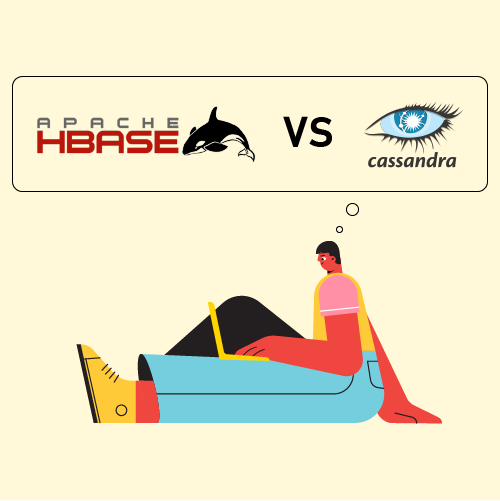
HBase vs Cassandra: Which is Better of the Two NoSQL Databases?
Selecting the best database management system is the key to ensure effective, streamlined app development process and a successful end outcome. However, choosing an ideal system for a project is not very easy for there are always a number of details to be considered at every turn. Especially when it impacts the performance of your…








